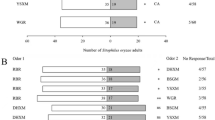Abstract
Previous studies have shown that larvae of the eastern tent caterpillar (Malacosoma americanum F.) mark trails, leading from their tent to feeding sites on host trees, with a pheromone secreted from the posterior tip of the abdominal sternum. 5β-Cholestane-3,24-dione (1) has been identified as an active component of the trail. The larvae have a threshold sensitivity to the pheromone of 10−11 g/mm of trail. Several related compounds elicit the trail-following response. Two other species of tent caterpillars also responded positively to the pheromone in preliminary laboratory tests.
Similar content being viewed by others
References
Augustine, R.L., 1972a, 1972b, Steroid Hydrogenation in “Organic Reactions in Steroid Chemistry” Vol. 1, p. 130, p. 123, J. Fried and J.A. Edwards eds., Van Nostrand Reinhold New York.
Combe, M.G.,Henbest, H.B., andJackson, W.R. 1967. Aspects of Stereochemistry. Part XXI.J. Chem. Soc. (C) 2467–2469.
Fitzgerald, T.D., andEdgerly, J.S. 1982. Site of secretion of the trail marker of the eastern tent caterpillar.J. Chem. Ecol. 8:31–39.
Fitzgerald, T.D., andPeterson, S.C. 1983. Elective recruitment communication by the eastern tent caterpillar (Malacosoma americanum).Anim. Behav. 31:417–423.
Jaffe, K. andHowse, P.E. 1979. The mass recruitment system of the leaf cutting ant,Atta cephalotes (L.).Anim. Behav. 27:930–939.
Long, D.B. 1955. Observations on sub-social behaviour in two species of lepidopterous larvae,Pieris brassicae L. andPlusia gamma L.Trans. R. Entomol. Soc. London 11:421–437.
McManus, M.L., andSmith, H.R. 1972. Importance of silk trails in the diel behavior of late instars of the gypsy moth.Environ. Entomol. 1:793–795.
Morgan, E.D. 1984. Chemical words and phrases in the language of pheromones for foraging and recruitment, pp. 169–194,in Lewis, T. (ed.). Insect Communication. Academic Press, New York.
Ochi, K., Matsunaga, I., Shinodo, M., andKaneko, C. 1979. Synthetic studies of vitamin D3 analogues from bile acids. Part 2.J. Chem. Soc. Perkin 1:161–164.
Still, W.C., Kahn, M., andMitra, A. 1978. Rapid Chromatographic technique for preparative separations with moderate resolution,J. Org. Chem. 43:2923–2925.
Tumlinson, J.H., Moser, J.C., Silverstein, R.M., Brownlee, R.G., andRuth, J.M. 1972. A volatile trail pheromone of the leaf-cutting ant,Atta texana.J. Insect. Physiol. 18:805–814.
Author information
Authors and Affiliations
Rights and permissions
About this article
Cite this article
Crump, D., Silverstein, R.M., Williams, H.J. et al. Identification of trail pheromone of larva of eastern tent caterpillarMalacosoma americanum (Lepidoptera: Lasiocampidae). J Chem Ecol 13, 397–402 (1987). https://doi.org/10.1007/BF01880088
Received:
Accepted:
Issue Date:
DOI: https://doi.org/10.1007/BF01880088




